Good morning.
I am so glad to see you today. Thank you for coming out to help us begin IUP’s 149th school year.
As we gather this morning, higher education is facing its most challenging times in at least 50 years. And as you well know, IUP is facing its most challenging times in over a century, but it’s not unprecedented territory for our great university.
In IUP’s history there were several times when myriad challenges nearly destroyed us. But if you look at that same history, you’ll see that we adapted, we survived, and then we thrived.
Today we have the opportunity to write this next chapter of our history as a story of resilience and teamwork that led to brighter days. There is more hard work ahead, but I am excited by the possibilities.
We have a good plan, and we need every one of us to pitch in and do our share. I believe we can do this. With your help, we will do this.
We all need to be on the same page, or row in the same direction, or get on the same bus, or whatever idiom you like. We need all of you and your ingenuity if we are to build an agile university that can rise to the opportunities and challenges we face.
On April 19, 2022, I talked about “The Future of IUP.” I said we can no longer see students as a one-size-fits-all group from similar backgrounds, with similar needs, seeking the same thing delivered the same way. Instead, we must see our students as unique individuals who we must help succeed, no matter what their needs.
So, instead of this,

we need to view our students like this.

No matter your role in the university, this applies to you. When it comes to supporting our students, the worst thing any of us can say is, “That’s not my job.”
It is my job. It is your job.
Our plan has five main strategies all focused on better serving students—today’s students and the new ones to come.

The first thing we must do, and the most important of these five items, is to become so adept at student-centeredness that we keep every student who comes to IUP.
The undeniable truth is that our downward enrollment trajectory would not have been as steep if we were better at retention. Until we began addressing this issue a few years ago, we seemed to not mind that three out of 10 first-year undergraduate students didn’t come back for a second year. [1]
This year, we are expecting an increase in our class of first-year students, but if our retention and persistence rates do not improve, our enrollment will not either. We simply cannot lose students at such an alarming rate.
We must support them in every step along their IUP journey.
This does not mean that we shouldn’t be challenging our students to achieve great things. It means we need to clear obstacles that hold back so many students—like cost of attendance and food insecurity and arcane bureaucratic processes. Then they can focus on the challenges, academic and otherwise, that will help them grow, meet our standards, and achieve their goals.
Some of you may remember Biosphere 2. It’s a three-acre enclosure in the Arizona desert with a controlled environment for studying the growth of plants and animals.
In this perfect environment, trees grew quicker than in the outside world, but they soon collapsed under their own weight.
The explanation was simple. In the biosphere, there was no wind.
Wind causes trees to sway back and forth. To adapt and survive, a tree’s fibers grow strong, giving it the ability to withstand the movement. [2]
How does this apply to IUP? College is meant to challenge students. It did when we were students. It always will.
We want our students to thrive so they can stand tall and strong. They need to face constructive challenges along the way—weathering them like a tree in the wind—and benefiting their long-term growth. That’s what a college education is all about.
Even the mightiest of oaks at one point needed a supporting stake until it could stand alone.
The second thing we must do is grow our market share in traditional markets.

To do that, we must be exceptional in our recruiting and marketing, we must offer in-demand, high-quality programs—and provide them with adequate resources—and we must do this at an affordable price.
The third item is to supplement our enrollment through other student groups outside of our core audiences.
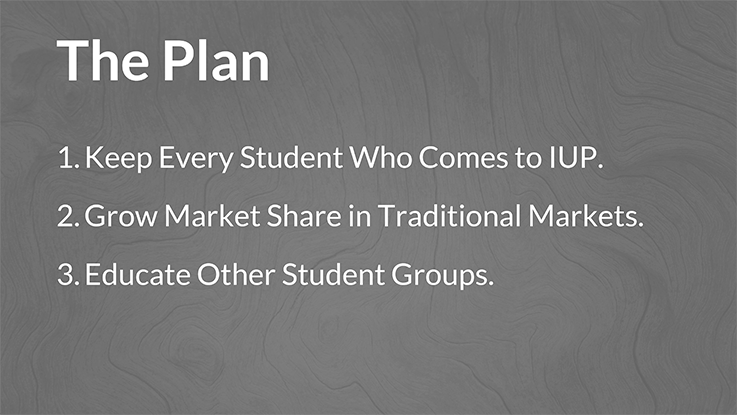
We need to re-grow international enrollment. Last year, we had 403 international students. Ten years ago we had 863. [3] Economics, politics, and the COVID-19 pandemic have had a lot to do with the decline, but we must bring in more students from all over the world who will add to our culture and our community.
We must add students to dual-enrollment and degree-completion programs. We must repackage our existing expertise in new ways to meet today’s students’ needs.
An example of attracting new audiences would be our College of Osteopathic Medicine. It’s a daunting—but achievable—proposition, and the long-term payoff would be astounding, transforming rural healthcare while boosting IUP’s regional and national profile—and finances.
Fourth, we must grow IUP’s reputation via academic quality, student-centeredness, return on investment, and research impact.
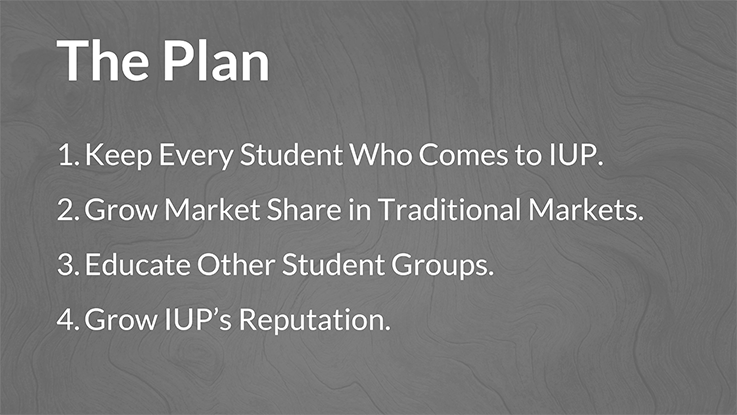
A college of medicine will also help.
Lastly, we will find alternative revenue streams to support our work.
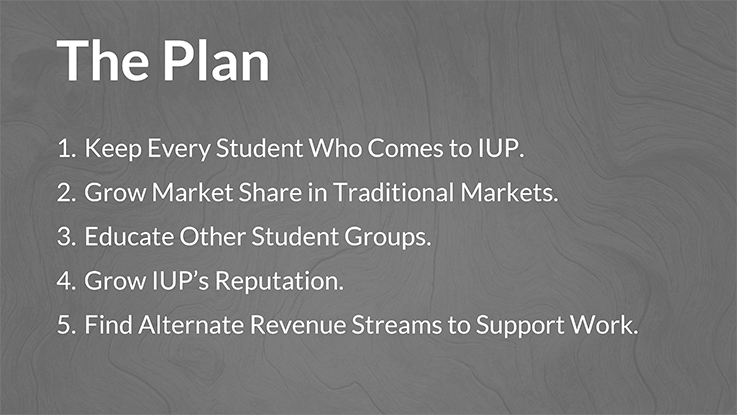
We cannot rely on tuition and appropriations alone, so we must use our skills and talents to increase revenue with more sponsored research activity, more philanthropic gifts, and any other possible avenue.
I believe these five strategies will shape the future of IUP. We must work together to implement them.
Our plan will help us sail smartly across today’s rough seas.
IUP is not sailing alone. Across the country, higher education is struggling. Enrollments are down. Budgets are not balanced, and the value of a college degree is being universally questioned rather than universally celebrated.
Here are some hard truths that make our plan necessary.
First, our state continues to underfund public higher education, which undermines the mission of the State System: to provide high-quality education at the lowest possible cost. [4]
In 2022, Pennsylvania ranked 49th out of 50 states in funding for public higher education per full-time student. Eleven states spend more than double what Pennsylvania does. [5]
This comes at a time when a recent national poll showed that 34 percent of young adults who aren’t enrolled in college said it’s because they couldn’t afford it. [6]
The number of high school graduates in Pennsylvania this year dropped slightly from 2022. But there is a dramatic drop looming ahead.
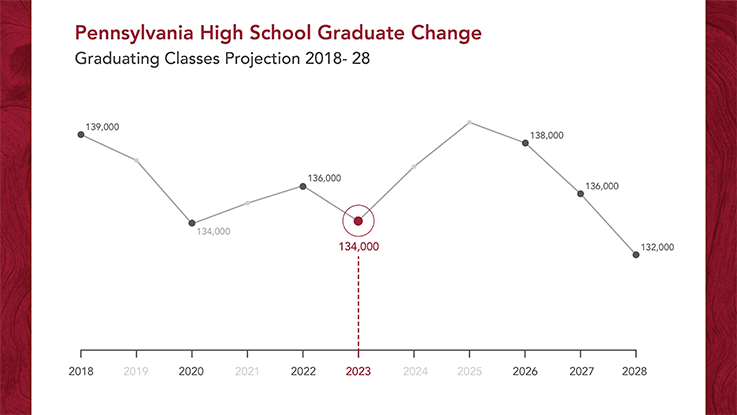
While the number of fish in the pond will be shrinking, there is a growing number of lines dropped in the water to attract those fish.
High school graduates have nearly 300 options for colleges, universities, and trade schools in Pennsylvania. Only three states have more. [7] With many of our surrounding states—including Ohio and West Virginia—suffering from population decline, schools from those states have crossed the border at increasing frequency and dropped lines in our pond.
The lack of funding mixed with increased competition couldn’t come at a worse time: In 2015, 57 percent of Americans said they had a lot of confidence in higher education. In 2018, it was 48 percent.
Today, 36 percent. [8]
According to a 2021 study, 30 percent of 18- to 24-year-olds who are not enrolled in college view higher education as “a waste of money.” [9]
Put that all together, despite a 7.2 percent increase in the number of high school students across the United States from 2010 to 2020, there was a 4.6 percent drop in the number of college students.
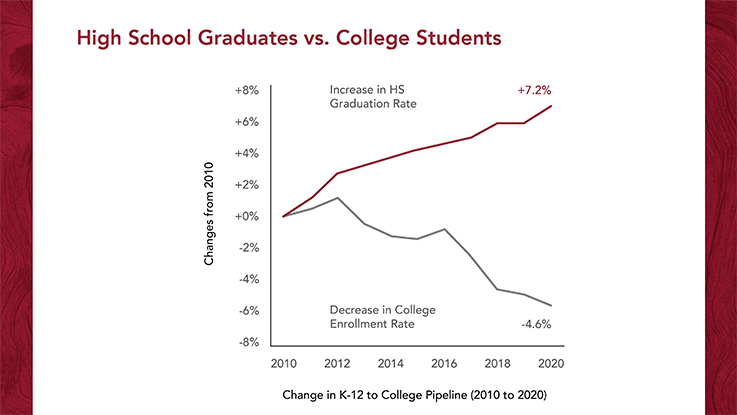
Those are the main external forces that turned the water around us so turbulent. We cannot change them. We must navigate through them, following our plan.
Our waters have been rough for a while. Rumors of IUP’s looming integration or demise are not true, but there are dark clouds over us.
Our enrollment has indeed dropped significantly. That’s not unique to IUP.
In 2010, nearly 120,000 students were enrolled in State System schools. Last year, it was around 84,000. [10] Across the country, it’s no different. Last year, there were almost two million fewer college students in the United States than there were in 2017. [11]
A drop in enrollment means a drop in revenue, so we had to cut our spending.
About 70 percent of our expenses are employee salaries and benefits. [12] So we made the difficult, but understandable, decisions to reduce our workforce. Those decisions have resulted in some good people losing their jobs. I know it has caused grief for the past and stress about the future.
The August 1 deadline to inform the faculty union of retrenchment plans this school year came and went without notification from me. We do need to make some additional adjustments in our faculty workforce, but not at the scale that requires retrenchment.
We need to make some more significant reductions in staff and administration. There will be open positions we will not fill, and some other savings should come through the departure of employees in position to retire. But that may not be enough, and some more difficult moves will likely have to be made.
Change will be a constant in the world and IUP must move with greater agility in response.
If you look around, you’ll see that many of you are already doing great things to help.
Our new student success infrastructure is up and running, with 15 new staffers in position to help every student weather the winds that blow at them. These navigators will serve as proactive and steady support for any facet of student life, which should ease some of the burden on faculty and staff and help improve retention.
Some people have questioned if the navigators are necessary. I say they are. Let me share a story to illustrate why.
In 2006, Bryant Pinder came to IUP from Philadelphia, unprepared for what was ahead of him. He quickly fell behind, with his GPA dropping every semester. He felt alone and lost. Nobody knew he needed help, and his isolation worsened the more he struggled.
After a year and a half of drifting aimlessly, Bryant was dismissed with a 0.72 GPA.
Many students who fail in college never try to come back. But after working three jobs for a few years, Bryant decided in 2014 that he would try again. He contacted IUP and enrolled in our Fresh Start program.
Bryant was connected with Dr. David Ferguson, who served as the mentor Bryant couldn’t find his first time around. Dr. Ferguson helped Bryant find an academic program in which he felt comfortable. Dr. Ferguson and some of Bryant’s faculty members teamed up to make a plan just for him. This time, Bryant felt like he was prepared to succeed.
Bryant soon found he did belong here, and in 2017, he graduated from IUP.
This summer, Bryant was hired as a navigator. In this role, he will focus on providing the kind of care and guidance he needed, but did not get, when he first came to IUP. Imagine how Bryant’s life would have been impacted had there been someone who threw him a life raft when he was struggling. Imagine how many other students we have lost over the years because nobody knew they were having a tough time. Imagine where we would be today if 3 out of 10 first-year students didn’t give up.
With the navigators in place, we have the support system that will ensure every student has the tools to succeed. Their work, combined with our collective drive to help students, should result in increased retention and persistence.
That’s why we need the navigators.
Here are a couple of other examples.
As the director of the IUP Marching Band, Dr. Zach Cheever has done a remarkable job of bringing pride and prestige back to The Legend, and he’s been here for only about a year.
Dr. Cheever has actively recruited students to come to IUP and join the band. Maybe you have seen some of the signing ceremony photos posted on social media that show the excitement and pride that comes when the marching band gets a new member.
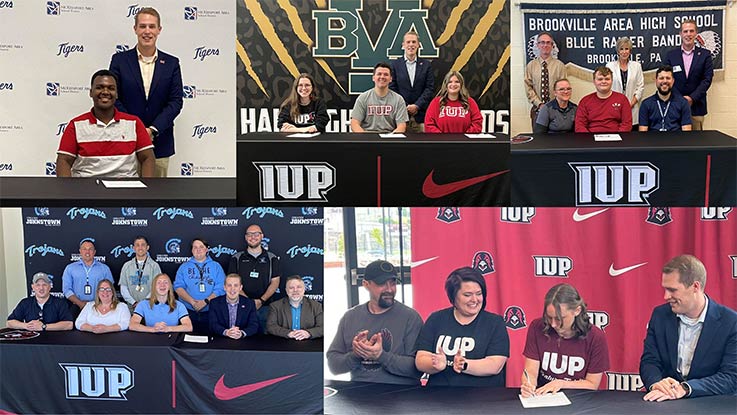
When Dr. Cheever came to IUP last summer, the marching band had 88 members. This fall, it has 165.
Dr. Prashanth Bharadwaj, from the Eberly College of Business, began a program last year that brought students from Kenya to IUP to enroll in some of our graduate programs.
This program gives students an affordable opportunity that they otherwise may not have had, creating a pipeline of students who we hope to benefit from for many more years. The first class of students came last fall, and many more are expected this year.
Students are our lifeblood, and their success is paramount to our future. These are great examples of how we can help grow IUP enrollment, which in turn will help us get to solid ground.
Our country is divided, and the rest of the world is unstable. We’re still emerging from a pandemic that took the lives of millions of people. Inflation is high and family budgets are being strained. Our university—along with many others—is struggling financially because of those external forces. Also, we need a time machine. It would be nice to go back about 20 years to adjust decisions that made sense then but are causing problems now.
While this is an accurate depiction of IUP in 2023, it’s also an accurate picture of where we stood a little more than 100 years ago.
Following World War I and the influenza pandemic in 1918, things at Indiana State Normal School were not looking good. [13]
Enrollment was down significantly. In the previous decade, the school had borrowed heavily to construct new buildings, and the debt was now due. Things were made worse because rampant inflation forced families to make tough decisions about their future.
But we recovered. We pitched in and we worked together, knowing better days were ahead if we just kept reaching for the horizon.
That’s what we are called to do today.
We must have faith that we are on the right path. We must believe that the priorities we have will pay off. We must move confidently toward our future, equipped with the knowledge that we have done this before—and we will do it again.
Maybe a better way to put it is to look to the song long associated with the IUP Marching Band. I am not Dr. Piper, so I’m not going to sing, but the third verse of "Amazing Grace" contains these 24 powerful words:
Through many dangers, toils and snares,
I have already come;
’Tis grace has brought me safe thus far,
And grace will lead me home.
We must adapt so we can survive, and then we can thrive.
We have the plan. We have the skill. We have the people.
Our future is now.
I may not be Dr. Piper, but I am the president and I can do this to close out today’s program: Here is Dr. Zach Cheever and The Beast of the East, The Legend, the bigger and better IUP Marching Band.
[1] IUP Comprehensive Planning Process, September 28, 2022
[2] The Role of Wind in a Tree’s Life, awesci.com, December 28, 2014
[3] IUP Fall Enrollment Bookmark Archive, IUP.edu
[4] About the State System, passhe.edu
[5] 2022 State Funding and Enrollment Report, State Higher Education Executive Officers Association.
[6] 1 in 3 Recent High School Grads Skipping College Because ‘It’s a Waste of Money’, intelligent.com
[7] Fighting for Scraps in Pennsylvania, Inside Higher Ed, July 12, 2023
[8] Americans’ Confidence in Higher Education Down Sharply, Gallup, July 11, 2023
[9] 1 in 3 Recent High School Grads Skipping College Because ‘It’s a Waste of Money', intelligent.com
[10] Overall Enrollment Decline in Pa.’s State Universities Rivals Last Year’s Drop, but the Number of Freshmen Is Up, Philadelphia Inquirer, October 3, 2022
[11] Fall 2022 Report, National Student Clearinghouse Research Center
[12] IUP Comprehensive Planning Process, September 28, 2022
[13] The IUP Story: From Normal School to University, Charles D. Cashdollar